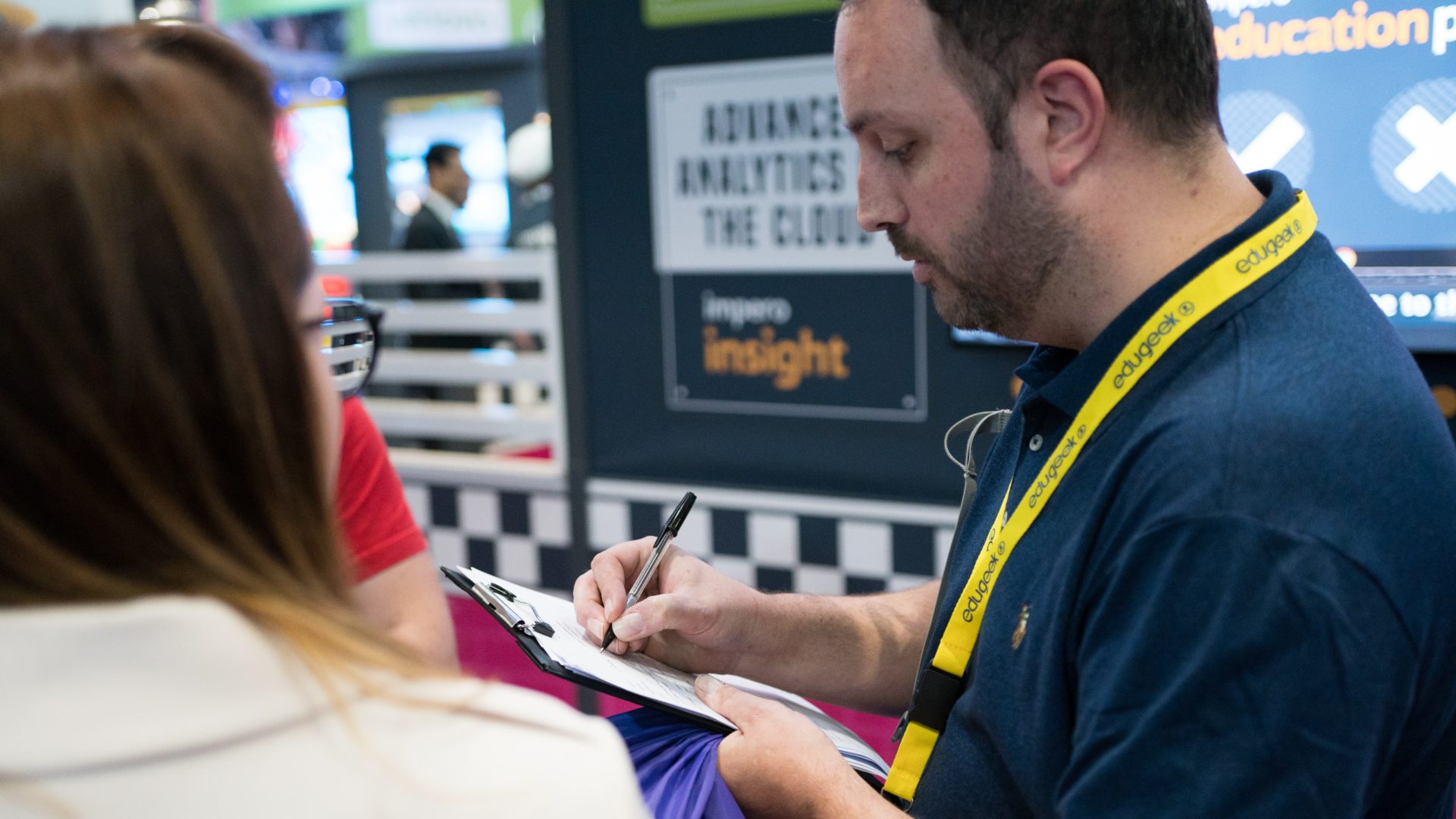For many organisations, trade shows and events play a huge role in their marketing strategy: Forrester found that events account for 18% of all B2B marketing spend.
Why do businesses invest so heavily in events? To generate leads.
One of the most popular methods of lead capture at trade shows are paper lead capture forms, which allow exhibitors to take down people’s contact details and notes of their conversation during the event.
But are paper forms still the best option for event exhibitors, or could an alternative lead capture method provide better results? In this article I cover:
- Using paper forms at trade shows
- What makes a good lead capture form?
- Do paper lead capture forms work for event exhibitors?
- Do paper lead capture forms work for event visitors?
- Understanding the problems with paper lead capture forms
- Is there an alternative to using paper lead capture forms?
Using paper forms at trade shows
Many companies use paper forms because they are an easy, flexible way to collect leads.
It’s easy to customise a paper form to meet your business needs. You have complete control over the questions you ask and the layout of the form. You can create different forms for different business units, or include lists of your entire product range, so you can have a detailed record of exactly what the person you spoke to at a show was interested in.
But after the event, paper forms create a lot of admin work for your marketing team. Each form needs typing up, to get your event leads into your databases or CRM systems. This is a painstaking process, made more difficult by hard-to-read handwriting.
Handwritten forms increase the likelihood of inaccurate lead data being entered into your systems, and make it more likely that some of your event leads will become unusable.
What makes a good lead capture form?
If you’re using paper lead capture forms at events and trade shows, here are the three things that make your forms great:
1) Simplicity
On a busy trade show booth, your reps need to be able to note down people’s information quickly and easily. Make sure your forms are simple, so your team can focus on having a conversation with the person visiting your booth, rather than finding the right box to tick on your form.
2) Length
The person visiting your booth doesn’t want to spend half an hour painstakingly filling out six pages of information with your rep. Unfortunately, paper forms are often designed as a ‘catch all’, to cover every eventuality. This means that the majority of the form won’t be relevant to any one person you’re speaking to, but might be relevant to the next dozen visitors to your booth.
From our experience, we find the ideal form should be no longer than the ideal qualifying conversation you have at your stand. You don’t want to collect information that’s unnecessary or irrelevant, just because there’s a field about it on the form.
3) Collects the information you need
Customize your lead capture forms so they ask questions tailored to your business and products.
One of the biggest challenges with other lead capture methods, like badge scanners or business cards, is that they’re not designed to collect the information you need.
Badge scanners rely on the data collected by the event organizers, and just give exhibitors access to that. Business cards simply give you someone’s contact details. Paper lead capture forms give you more flexibility, as long as you put the thought in when creating the form.
Do paper lead capture forms work for event exhibitors?
Paper forms are a popular lead capture tool for exhibitors, because they’re the simplest option. There’s no cost associated with them (aside from printing); you don’t have to book ahead like if you’re renting badge scanners; and you can easily change the design, questions and layout to meet your changing business leads.
However, in 2019, being the company at the show still shuffling piles of paper and taking people’s details with pen and paper can look unprofessional and outdated.
So while paper forms work well enough for exhibitors before and during shows, it’s after the event where exhibitors pay the price.
The time it takes to type up all your lead capture forms means your follow-up is delayed, which harms your post-event conversion rates.
Do paper lead capture forms work for event visitors?
The short answer: it depends.
Some lead capture forms are easy to fill out. Others are visually chaotic and take a lot of time and attention for your stand visitor to fill in.
The other drawback is that paper forms require a lot of manual data entry after an event, before your sales team can follow up. This means that event visitors are kept waiting to hear back from your company, which can quickly undo the good first impression they had when they met your reps at the booth.
The longer they wait to hear from your business, the more likely it is that you’ve slipped down their priority list, and the less likely you are to hear from that person again.
Understanding the problems with paper lead capture forms
The biggest problems with paper lead capture forms are:
- Speed: completing a paper form is a slow process.
- Data entry: after an event it will take a lot of work to type up the forms, to get the data into your existing systems.
- Data quality: something as simple as messy handwriting can make your forms illegible, meaning you have to discard a number of your leads.
- Follow-up: because it takes time to type up your forms, it also takes time to follow-up with your leads, by which time they’ll have forgotten about you, or be a few steps into the buying process with your competitors.
Paper forms are one of the oldest lead capture methods. But they’re simply too manual and too disconnected from the rest of your tools and technology to keep up with the fast-paced demands of modern business.
We live in a world where we expect information, products and services instantly, at the click of a button. But if you’re collecting event leads using paper forms, you’re going against everything you and your customers demand today.
Is there an alternative to using paper lead capture forms?
There are several alternative methods for capturing leads at trade shows and events, that don’t involve hiring badge scanners:
- Hire badge scanners. Badge scanners allow exhibitors to quickly and easily collect people’s contact details by scanning their visitor badges. However, it’s difficult to customize the information you collect. And you will have to wait several days after the event to get your lead data back from the event organizer, meaning you’ll still have the problem of slow follow-up.
- Collect business cards. When you scan someone’s badge at an event, most of the time you only get their basic contact information: name, email address, company, job title. All of that can be found on their business card. But not everyone carries business cards and, again, they’ll give your team lots of manual data entry.
- Online lead capture forms. Some companies have started using tools like Typeform or Google Forms to set-up online lead capture forms. These look great, but are difficult to customize. And run the risk of breaking down entirely if the trade show Wi-Fi isn’t up to scratch of you don’t have signal.
- Universal lead capture solution. An event lead capture solution like Integrate Events combines the best of both worlds: you can scan badges or business cards, and you can enter extra information to provide context around your conversation. It also works offline, so you won’t get caught-out by intermittent Wi-Fi at the event. (Note: Different lead capture solutions offer different functionality, so be sure to check before you buy.)
Many companies use paper lead capture forms at trade shows because it’s what they’ve ‘always done’. But a little bit of research can reveal more efficient ways to collect leads at trade shows – methods that can save on data entry time, without compromising on the quality of the lead data collected.
Closing thoughts
Today’s consumers are used to having immediate access to information – at the click of a button, or at the very latest, same day. But if you use paper forms to collect leads at trade shows, you’re going to fall far short of their expectations.
For starters, it normally takes days, if not weeks, for teams to type up their paper forms, ready to upload into their CRM. Only once the data’s been transcribed and tidied up, and your CRM team has loaded it onto the system, can your sales team start following up.
That could take anywhere from a few days to a few weeks. By that time your prospects will have forgotten all about you.
Your customers deserve better. It’s time to leave paper lead capture forms behind, and switch to an event lead capture solution that can cope with the pace of modern sales, marketing and business.
Ready for the next step? Download our guide - How to capture the best leads at events.




